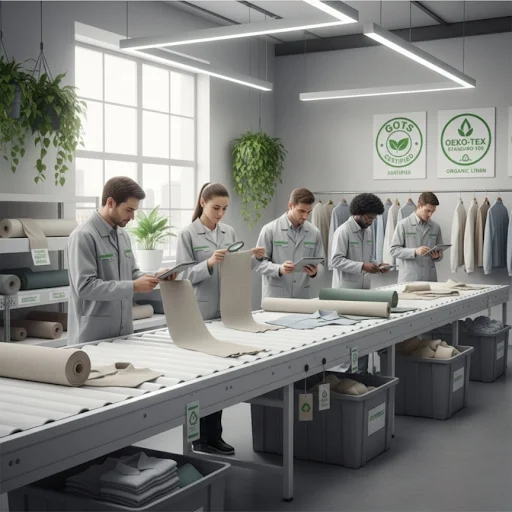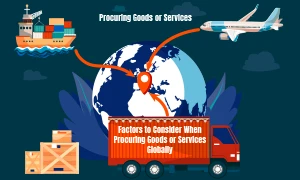
(QC) is crucial for sustainable and ethical apparel manufacturing, as it ensures quality, minimizes waste due to defects, and verifies compliance with ethical standards for materials and labour. By applying strict QC from raw materials to final inspection, manufacturers cut material waste and save energy. They can identify and address poor labour practices, enhance consumer trust, and prevent costly recalls or returns, thereby creating a supply chain that is both sustainable and responsible.
This blog explains how garment QC builds a sustainable, ethical manufacturing industry by reducing environmental impact, protecting workers, and earning consumer trust.
Why Garment QC is Central to Sustainable Apparel Manufacturing?
Quality control is more than a tool for product standards. It serves as a foundation for sustainability in manufacturing, enabling brands to reduce waste, conserve resources, and produce garments that last longer.
Reducing Textile Waste
Waste is one of the biggest challenges in the fashion industry. A single batch of fabric cut incorrectly or garments made in the wrong size can result in thousands of items being discarded. Quality control helps prevent this outcome by catching mistakes before they spread, which leads to:
- Prevention of large-scale defects before they impact entire batches
- Less rework and lower levels of fabric and material waste
- More efficient use of raw materials throughout production
Example: A factory producing 20,000 shirts discovered sizing errors only after the final stage. Without QC, the entire order would have been rejected, but early in-process inspections reduced the defect rate to just 2%, saving thousands of shirts from being discarded.
Saving Energy and Resources
Every production error consumes more than just fabric. It drains valuable resources like water, dyes, electricity, and machine hours. By increasing first-pass yield and ensuring garments are made correctly the first time, QC helps factories operate more efficiently and lower their environmental impact through:
- Conservation of water, dyes, and chemicals that would otherwise be wasted
- Reduced electricity use and fewer machine hours lost to rework
- A smaller overall carbon footprint in apparel manufacturing
Example: Denim production is water-intensive, with a single pair of jeans requiring thousands of litres. A QC check that spots incorrect dyeing early can prevent re-dyeing an entire batch, saving both water and energy.
Promoting Product Durability
True sustainability goes beyond how clothes are made; it also depends on how long they last. Garments with strong seams, accurate sizing, and consistent fabric quality don't wear out quickly or lose shape after a few washes. Quality control ensures this level of durability, allowing consumers to buy less frequently and keep their clothes in use for longer through:
- Stitching and finishing that can withstand long-term wear
- Accurate sizing that improves fit and reduces returns
- An extended garment lifespan that helps cut down on overconsumption
Example: Outdoor brands like Patagonia have built their reputation on durable, long-lasting clothing. QC processes such as seam-strength testing and fabric wear resistance checks ensure their jackets and backpacks can withstand years of heavy use, aligning durability with sustainability.
How QC Supports Ethical Manufacturing?
Quality control also plays a vital role in promoting ethics within apparel manufacturing, ensuring that the way garments are made is as responsible as the products themselves.
Safeguarding Workers
Quality control is not limited to garment checks alone. It also extends to factory conditions, where teams verify that workers are safe, that no child or forced labor is present, and that wages and working hours meet legal and ethical standards. In this way, QC acts as a safeguard for human rights as much as for product quality by:
- Checking compliance with fair wage, safety, and labor regulations
- Identifying and preventing risks of child or forced labor
- Promoting safe, respectful, and legally compliant workplaces
Example: A supplier in Bangladesh once faced order cancellations after international buyers discovered unsafe fire exits during audits. Regular QC inspections, which include safety checks, prevent such risks, protecting workers and maintaining secure supply chains.
Increasing Transparency
Modern consumers want more than just stylish clothing; they want proof that garments are made responsibly. QC reports give brands the verified data they need to share with their customers, demonstrating that production meets global standards for fairness and safety. This transparency strengthens accountability across the supply chain by:
- Providing documented evidence of ethical production standards
- Holding brands and suppliers accountable for fair practices
- Supporting claims of responsible sourcing with verifiable proof
Example: Brands like Everlane have built their reputation around "Radical Transparency," openly sharing details of their factories and QC audits. Such a practice reassures customers that real data backs ethical promises.
Building Consumer Trust
Ethical fashion is built on trust. Brands that can confidently back up their claims with independent QC inspections gain a clear advantage in a competitive market. Ethical QC is not only about compliance but also about building credibility and long-term loyalty with consumers who care about where and how their clothes are made. It supports ethical fashion by:
- Validating promises of sustainable and ethical production
- Strengthening loyalty through transparency, consumers can rely on
- Enhancing brand reputation in the conscious fashion market
Example: Patagonia has consistently used rigorous QC and third-party certifications to prove its commitment to fair labour and sustainability. Such transparency has built strong customer loyalty, with buyers often choosing Patagonia over cheaper alternatives because they trust the brand's values.
The link between ethics and accountability becomes even clearer when we look at the practical QC practices that help brands achieve these goals.
Key QC Practices That Drive Sustainability and Ethics
Practical QC measures ensure that sustainability and ethics are not just promises but everyday realities in garment manufacturing. These practices cover everything from raw materials to factory conditions, making QC an essential bridge between brand commitments and consumer expectations.
Raw Material Inspections
Checking fabrics, dyes, zippers, and trims before production helps catch problems before they escalate into large-scale defects. Early inspections reduce waste and ensure only safe, compliant, and sustainable materials enter the supply chain. They allow QC teams to:
- Identify fabric inconsistencies or defects before bulk cutting
- Ensure dyes and chemicals meet international safety standards
- Prevent hazardous materials from entering production lines
Example: A European fashion brand discovered through raw material QC that a shipment of fabric contained banned azo dyes. Early detection prevented thousands of non-compliant garments from being produced, saving the brand from a costly recall.
In-Process Inspections
Monitoring stitching, sizing, and finishing during production ensures mistakes are caught early rather than at the end. In-process QC reduces rework and helps factories maintain steady, high-quality output. It allows teams to:
- Ensure size charts are followed consistently
- Catch issues such as weak seams, loose threads, or color mismatches
- Reduce large-scale waste by correcting errors during production
Example: A factory in Mexico reduced defect rates by 30% after adding mid-production QC checkpoints for stitching strength, preventing thousands of garments from failing final inspection.
Final Random Inspections (AQL)
Before garments are shipped, QC teams perform random sampling based on Acceptable Quality Limit (AQL) standards. This statistical method ensures shipments meet agreed quality levels and protects brands from widespread defects. AQL inspections are designed to:
- Provide unbiased, measurable inspection results before shipment
- Guarantee shipments meet international buyer requirements
- Reduce risks of rejected orders and costly returns
Example: An American retailer avoided significant delays after an AQL inspection in China flagged inconsistent labeling in a shipment of jackets. The supplier corrected the issue before shipping, preventing rejected orders at customs.
Social and Ethical Audits
Beyond technical checks, QC often includes workplace assessments that ensure factories follow fair labor and environmental standards. Social audits verify compliance with ethical commitments and protect brand reputation. These audits typically:
- Evaluate working hours, wages, and worker safety conditions
- Ensure no child or forced labor is involved in production
- Monitor environmental practices such as wastewater treatment and chemical handling
Example: In Cambodia, several garment suppliers improved worker retention and secured long-term contracts after social audits verified fair wage systems and safe working conditions, strengthening both ethics and efficiency.
Sustainability-Oriented Testing
Advanced QC labs now go beyond basic inspections to include tests that directly support sustainability goals. These specialized checks help brands verify environmental responsibility and product safety by focusing on:
- Microfiber shedding, which contributes to ocean pollution
- Fabric durability, ensuring garments have a longer lifecycle
- Chemical compliance with standards such as REACH, CPSIA, and OEKO-TEX®
Example: A leading apparel brand recently strengthened its eco-friendly reputation by testing garments for microfiber release and fabric durability, ensuring products not only met safety standards but also aligned with sustainability goals.
Challenges in Implementing Ethical QC
While technology and best practices make QC more effective, there are still real supply chain challenges that brands and suppliers must overcome to embed sustainability and ethics into garment production.
Cost Pressures
Many factories, especially smaller ones, view QC as an added expense rather than a long-term investment. Without understanding the savings from reduced waste and fewer returns, they may cut corners or resist implementing rigorous checks.
Complex Supply Chains
Garment production often involves multiple tiers of suppliers, from fabric mills to dye houses to stitching units. Inspecting and standardizing quality across all these layers can be difficult, especially when visibility into subcontractors is limited.
Varying Standards
Local regulations may differ from international expectations. What is legally acceptable in one country may fall short of global sustainability or ethical requirements, creating compliance gaps that put brands at risk.
Successful brands are those that approach QC as a partnership rather than policing. By investing in staff training, adopting digital inspection tools, and building long-term supplier relationships, they transform challenges into opportunities for stronger, more ethical supply chains.
As the industry looks ahead, these improvements pave the way for the future of QC, where sustainability, technology, and ethics will be even more tightly connected.
The Future of Garment QC in Sustainable Fashion
As sustainability and ethics become non-negotiable in the fashion industry, quality control will move from being a back-end process to a central part of brand strategy. QC will not just prove that garments meet standards today, but also provide the data and transparency needed to shape the industry of tomorrow.
Integration with ESG Reporting
QC data will feed directly into Environmental, Social, and Governance (ESG) reporting, helping brands meet the growing demands of investors, regulators, and consumers. By linking inspections to ESG metrics, brands can demonstrate measurable progress on sustainability and ethics.
To learn more about how Mexico is advancing sustainability in manufacturing, explore our insights on Mexico's sustainability measures and environmental regulations.
Consumer-Facing Proof
Future garments will carry digital product passports or scannable QR codes that trace every step of production. Consumers will be able to see when, where, and how their clothes were inspected, creating confidence that sustainability claims are backed by objective evidence.
Predictive QC
Artificial intelligence will go beyond detecting defects to predicting them before they occur. By analyzing data patterns from past inspections, predictive QC will help factories prevent errors, cut waste, and improve efficiency in real time.
Ensure Sustainable and Ethical Garment Production with SIXMexico
Build a supply chain that is both sustainable and ethical with SIXM's Garment Quality Control services in Mexico. Our inspections help you minimize waste, verify fair labour practices, and ensure every garment meets international standards for quality and responsibility.

